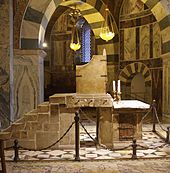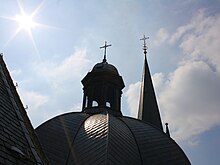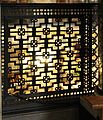Palatine Chapel, Aachen


The Palatine Chapel in Aachen is an
As part of Aachen Cathedral, the chapel is designated as a UNESCO World Heritage Site.[2]
History


The architect responsible, Odo of Metz, is named in a tenth-century inscription around the dome: Insignem hanc dignitatis aulam Karolus caesar magnus instituit; egregius Odo magister explevit, Metensi fotus in urbe quiescit. Nothing more is known of him. The building he designed has a simple exterior and a complex interior, with a double shell octagonal dome resting on heavy piers, a two-story elevation, and elaborate revetment[4] and decoration.
In 936
Structure



There is a sixteen-sided
The construction, including
The dome was decorated originally with a fresco, and later with mosaic. In the Baroque period, it was replaced by stucco. The original mosaic was reproduced in the 19th century with the same iconography as the original. It depicts the twenty-four elders of the Apocalypse bearing crowns and standing around the base of the dome. Above the main altar, and facing the royal throne, is an image of Christ in Majesty.[7] The upper gallery of the chapel was the royal space, with a special throne area for the king, then emperor, which let onto the liturgical space of the church and onto the atrium outside as well.
The inscription above the ground floor archer reads: "CUM LAPIDES VIVI PACIS CONPAGE LIGANTUR INQUE PARES NUMEROS OMNIA CONVENIENT CLARET OPUS DOMINI, TOTAM QUI CONSTRUIT AULAM EFFECTUSQUE PIIS DAT STUDIIS HOMINUM QUORUM PERFECTUI DECORIS STRUCTURA MANEBIT SI PERFECTA AUCTOR PROTEGAT ATQUE REGAT SIC DEUS HOC TUTUM STABILI FUNDAMINE TEMPLUM QUOD PRINCEPS CAROLUS CONDIDIT ESSE VELIT".[8]
The main entrance is dominated by a
The bronze doors symbolize the Carolingian Renaissance in metalwork, on a scale not seen since the Roman Empire.[9]
Gallery
-
seating arrangements on individual oak chairs
-
view up the nave
-
detail of marble-clad pillar
-
detail of inlaid floor
-
lights and details of chapiter
-
lectern bookrest in the form of an eagle
-
side view of lectern eagle
-
front 3/4 view of lectern eagle
-
choirmaster badalone in form of eagle
-
bronze-clad central doors
-
bronze-clad crypt door
-
marble-clad column
-
World War II memorial plaque
-
Pipe organ
-
Marble wall
-
metalwork grate
-
main altar
-
architectural detail of bell in tower
-
Wheel chandelier attributed to Frederick Barbarossa, night view from above
-
Wheel chandelier, daylight from below
-
artistic drawing of wheel chandelier
See also
- Aachen penny of Charlemagne
- Carolingian architecture
- History of medieval Arabic and Western European domes
- Symbolism of domes
Footnotes
- ^ a b Jeep 2001, p. 1
- ^ UNESCO 1992
- ^ Conant 1994, p. 47
- ^ Gould 2013
- ^ Garrison 2012, pp. 62–63
- ^ Bayer 2014
- ^ McClendon 2005[page needed]
- )
- ^ The Grove Encyclopedia of Medieval Art and Architecture. Edited by: Colum P. Hourihane. "Carolingian metalwork" OUP 2013
References
- Bayer, Clemens M. M. (2014). "Das Grab Karls des Grossen". In Pohle, Frank (ed.). Karl der Grosse: Orte der Macht: Essays (in German). Dresden: Sandstein Verlag. pp. 382–91. ISBN 978-3-95498-092-5.
- Conant, Kenneth J. (1994) [1959]. Carolingian and Romanesque Architecture (4th ed.). New Haven, CT: Yale University Press. LCCN 78149801.
- Garrison, Eliza (2012). Ottonian Imperial Art and Portraiture: The Artistic Patronage of Otto III and Henry II. Farnham, UK: Ashgate. LCCN 2011013779.
- Gould, Andrew (8 January 2013). "Marble Revetments". Orthodox Arts Journal. Retrieved 15 May 2015.
- Jeep, John M., ed. (2001). Medieval Germany: An Encyclopedia. New York, NY: Garland Pub. LCCN 00061780.
- McClendon, Charles B. (2005). The Origins of Medieval Architecture: Building in Europe: A.D 600-900. New Haven, CT: Yale University Press. pp. 108–119. LCCN 2004023967.
- UNESCO (1992). "Aachen Cathedral". UNESCO. World Heritage List. Archived from the original on 10 May 2015. Retrieved 15 May 2015.
External links
- Official Website of Aachen Cathedral (in German)
- Aachen Cathedral, inː Sacred Destinations (online travel guide)





















